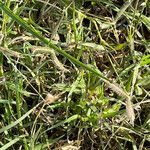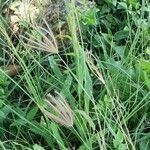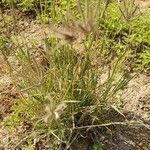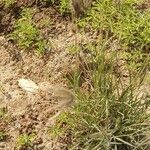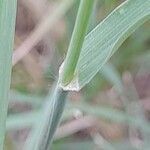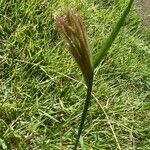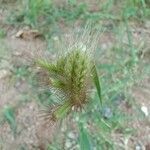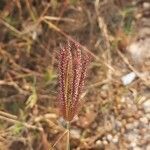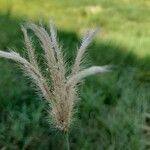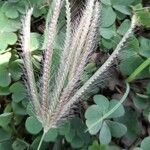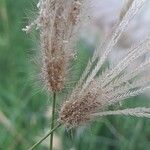Annuals or biennials, erect or decumbent, stolons usually absent. Flowering culms 40–90 cm high. Leaves: ligule 0.4–0.6 mm long; blade 10–24 cm long, 2–5 mm wide. Inflorescence branches 7–17, appressed to erect, 2–9 cm long. Spikelets subsessile or pedicellate, 3 (–4)-flowered, with 1 floret bisexual. Glumes smooth, with midnerve smooth or scabrous; upper glume 1.9–2.6 mm long. Callus bearded. Basal lemma 2–3 (–4) mm long, entire or obscurely lobed, cartilaginous, not sulcate, smooth, with silky, spreading hairs 1–1.5 mm long on upper submargins, often also pubescent on midnerve and occasionally pubescent on remainder of submargins; awn 1, 4.5–7 mm long. Caryopsis narrowly oblanceolate, 1.5–2 mm long, reddish brown. Incomplete florets 2–3, separated from the bisexual floret; lemma truncate, entire or obscurely lobed, inflated, awned.
Perennial; culms up to 1 m. high, loosely tufted, stoloniferous.. Leaf-blades flat, rarely involute, up to 40 cm. long, 2–3 mm. wide, tapering towards the apex.. Inflorescence of 5–15(–22) digitate, loose to spreading, purplish, feathery spikes 4–8 cm. long.. Spikelets 3-flowered, 3-awned; lower glume 1.2–1.5 mm. long; upper glume 1.7–2.5 mm. long; lowest lemma narrowly ovate-elliptic in side view, 2–2.5 mm. long, pallid, sparsely to densely ciliate on the margins and keel, the awn 4.5–7 mm. long; callus rounded, ciliate; 2nd lemma a glabrous clavate scale 1–1.5 mm. long, projecting from the side of the lowest lemma, different in shape, its awn 2.5–7 mm. long; 3rd lemma also reduced to a glabrous clavate scale 1 mm. long, its awn 3–5 mm. long.
Annual, 30–60 cm. high, often stoloniferous
